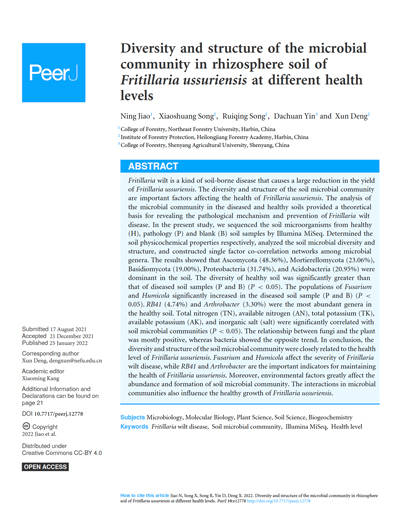NEWS 2022
Diversity and structure of the microbial community in rhizosphere soil of Fritillaria ussuriensis at different health levels
Ning Jiao1, Xiaoshuang Song2, Ruiqing Song1, Dachuan Yin3, Xun Deng2
PeerJ 2022
http://dx.doi.org/10.7717/peerj.12778
1College of Forestry, Northeast Forestry University, Harbin, China
2Institute of Forestry Protection, Heilongjiang Forestry Academy, Harbin, China
3College of Forestry, Shenyang Agricultural University, Shenyang, China
Abstract
Fritillaria wilt is a kind of soil-borne disease that causes a large reduction in the yield of Fritillaria ussuriensis. The diversity and structure of the soil microbial community are important factors affecting the health of Fritillaria ussuriensis. The analysis of the microbial community in the diseased and healthy soils provided a theoretical basis for revealing the pathological mechanism and prevention of Fritillaria wilt disease. In the present study, we sequenced the soil microorganisms from healthy (H), pathology (P) and blank (B) soil samples by Illumina MiSeq. Determined the soil physicochemical properties respectively, analyzed the soil microbial diversity and structure, and constructed single factor co-correlation networks among microbial genera. The results showed that Ascomycota (48.36%), Mortierellomycota (23.06%), Basidiomycota (19.00%), Proteobacteria (31.74%), and Acidobacteria (20.95%) were dominant in the soil. The diversity of healthy soil was significantly greater than that of diseased soil samples (P and B) (P <0.05). The populations of Fusarium and Humicola significantly increased in the diseased soil sample (P and B) (P <0.05). RB41 (4.74%) and Arthrobacter (3.30%) were the most abundant genera in the healthy soil. Total nitrogen (TN), available nitrogen (AN), total potassium (TK), available potassium (AK), and inorganic salt (salt) were significantly correlated with soil microbial communities (P <0.05). The relationship between fungi and the plant was mostly positive, whereas bacteria showed the opposite trend. In conclusion, the diversity and structure of the soil microbial community were closely related to the health level of Fritillaria ussuriensis. Fusarium and Humicola affect the severity of Fritillaria wilt disease, while RB41 and Arthrobacter are the important indicators for maintaining the health of Fritillaria ussuriensis. Moreover, environmental factors greatly affect the abundance and formation of soil microbial community. The interactions in microbial communities also influence the healthy growth of Fritillaria ussuriensis.




